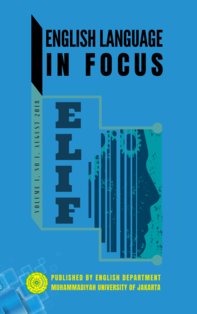Indonesian Islamic Children’s Literature: the Lexical Choices in the Religious Teachings
DOI:
https://doi.org/10.24853/elif.1.1.23-34Keywords:
lexical choices, religious teachings, Indonesian Islamic children’s literature.Abstract
The study discusses Islamic religious teachings presented in the Indonesian Islamic children’s literature through the uses of the lexical choices. The discussion covers the religious concepts and practices. For the purpose, the data were taken from five sample children story books of Seri Kalimat thoyyibah which is written by and translated by an Indonesians. The lexical choices presenting the Islamic religious teachings were analyzed by implementing the corpus method and using semantic theories of semantic field and relations. The analysis was also seen from the perspective of the characters’ age by referring to the idea of children psycholinguistic development. The findings show that the lexical choices presenting the concepts of Islamic teachings are mostly unsuited the age of the children characters, as well as the children target readers. This raises concern on the stories comprehensibility. On the other hand, the verb choices describing Islamic practices are friendlier to children readers.References
Adolps, S. (2006). Introducing Electronic Text Analysis: A Practical Guide for Language and Literary. London: Routledge.
Cann, R. (1993). Formal Semantics : an Introduction. Cambridge: Cambridge University Press.
Crawley, J., Ditzel, L., & Walton, S. (2012). Using Children’s Picture Books for Reflective Learning In Nurse Education. Contemporary Nurse, 42(1), 45–52. https://doi.org/10.5172/conu.2012.42.1.45
Cruse, D. A. (2004). Meaning in Language : an Introduction to semantics and pragmatics. Oxford: Oxford University Press.
Djatmika, D A N, K., & A, N. (2012). Systemic Strategies to Improve the Readability of the English Version of Indonesian Children Stories. K@ta, 14(2), 43–50. https://doi.org/10.9744/kata.14.2.43-50
Kearns, K. (2000). Semantics. New York: St. Martin’s Press.
Koenig, H. G., & Al Shohaib, S. (2014). Health and Well-Being in Islamic Societies: Background, Research, and Applications. In Health and Well-Being in Islamic Societies: Background, Research, and Applications (pp. 1–361). Geneva: Springer International. https://doi.org/10.1007/978-3-319-05873-3
Lyons, J. (1995). Linguistic Semantics : an Introduction. Cambridge: Cambridge University Press.
Malmkjær, K. (2018). Children’s Literature in/and Translation: The oeuvre as corpus. Ilha Do Desterro A Journal of English Language, Literatures in English and Cultural Studies, 71(1), 135–150. https://doi.org/10.5007/2175-8026.2018v71n1p135
McDevitt, T. M., & Ormrod, J. E. (2002). Child Development and Education. Ohio: Merrill.
McKay, S. L. (2001). Literature as Content for ESL/EFL. In M. Celce- Murcia (Ed.) Teaching English as Second or Foreign Language (pp. 319-332). Boston: Heinle & Heinle.
Saeed, J. I. (2003). Semantics. Oxford: Blackwell.
Tomlinson, C. M., Lynch-Brown, C., & Lynch-Brown, C. (1993). Essentials of Children’s Literature. Boston: Allyn and Bacon.
Trask, R. L. (Robert L. (1999). Key Concepts in Language and Linguistics. London: Routledge.
Downloads
Published
Issue
Section
License
Authors who publish with this journal agree to the following terms:
- Authors retain copyright and grant the journal right of first publication with the work simultaneously licensed under a Creative Commons Attribution License that allows others to share the work with an acknowledgment of the work's authorship and initial publication in this journal.
- Authors can enter into separate, additional contractual arrangements for the non-exclusive distribution of the journal's published version of the work (e.g., post it to an institutional repository or publish it in a book), with an acknowledgment of its initial publication in this journal.
- Authors are permitted and encouraged to post their work online (e.g., in institutional repositories or on their website) before and during the submission process, as it can lead to productive exchanges, as well as earlier and greater citation of published work (See The Effect of Open Access).


